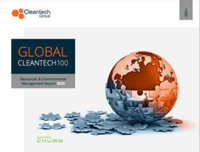Are Refill Models the Answer to Single Use Plastic?
There has never been greater pressure for corporations to act on plastics and single-use packaging. Many Fast-Moving Consumer Goods (FMCG) companies are strongly pursuing recycling strategies, but with the recycling infrastructure based on shipping waste thousands of miles away from where it is produced and with less than 10% of materials turned into something new, recycling is often inefficient and ineffective.
Packaging-free alternatives are emerging to challenge incumbent plastics, glass and packaging producers. One such business model is reuse and refill, where packaging is designed to be reusable, or products are distributed without packaging so consumers can use their own containers.

Attractiveness
The Ellen Macarthur Foundation estimates replacing 20% of global plastic packaging with reusable models presents a $10 billion business opportunity. Through speaking to innovators, corporates and investors in this sector, we can identify four key drivers at play for the sustainable packaging market:
- Environmental Impact: the impact of single-use plastic is increasingly clear for its impact on oceanic and terrestrial ecosystems, causing issues like ghost catch and bioaccumulation of microplastics, which eventually returns to humans in the food we eat. Single use glass is less well known but with significant carbon footprints from furnaces and shipping many are looking to next address single-use glass.
- Regulatory Pressure: To date 25 countries, and over 100 cities have initiatives banning single-use plastic.
- Consumer Demand: Public awareness of plastics impact is high and is forcing companies to change packaging materials and trial reuse models. In August 2019, Coca-Cola replaced plastic with aluminum for its Desani water brand in the U.S. Northeast following backlash against plastic.
- Market Pressure: Corporates have publicly committed to eliminate single-use plastics and packaging which is not reusable, recyclable, or compostable via consortiums e.g., Ellen MacArthur Plastics Pact or Australian packaging Covenant.
Recycling markets have been based on waste exports, predominantly to Asia. In Asia, packaging demand growth is faster than global growth rates, and waste-collection systems and recycling infrastructure are not in place at the required scale. These countries waste processing capacity has been occupied by western waste (the largest exporters being the US, Germany and Japan), while their own waste production is increasing.
China’s national sword policy in 2018 which banned accepting only but the cleanest of waste, has disrupted export markets. More countries have followed suit including Turkey, who was the largest net importer in 2019. Reducing the economics of recycling and leading governments to crack down on packaging producers to reduce waste. This has materialized in the form of plastics taxes and Extended Producer Responsibility policies. Therefore, incentivizing reduction in packaging use.
For business there are many advantages for adopting reuse models including:
- Increased engagement and brand loyalty with consumers with digital tools like QR codes enabling feedback on consumer preference and behaviors.
- Reducing the cost of production, processing, and packaging with the return of specially formulated materials.
- Operational optimization and economies of scale by standardizing design and working cross brand and even company.
Business Models
There are four distinct business model types as identified by the Ellen Macarthur Foundation in 2019 as noted in Figure 2 below.

Cleantech group spoke to Ivana Sobolikova, Partner responsible for Investor Relations and Impact at MIWA, a designer, developer, and operator of refill and return on the go systems in Europe. Ivana explained how MIWA takes a full system approach with three offerings including:
- B2B smart reusable canisters to dispense bulk goods like rice or laundry detergent.
- B2B smart refill modules (smart shelfs) with electronically controlled sensing valves with consumer interface. In its next upgrade MIWA plans to implement an integrated scale helping consumer dispense the exact amount they want.
- B2C smart reusable packaging and corresponding app connecting all offerings to enable an autonomous reuse solution.
B2B solution is offered as a service with MIWA providing for reverse logistics, sanitation and reuse of the material once it has reached end of a life.

Based on a Life-Cycle Assessment (LCA), their solution is designed to reduce the environmental footprint by up to 71% compared to linear consumption models, using only 10% of packaging materials compared to single use and 62% decreased carbon footprint. Ivana explained MIWA’s business model development ‘The as-a-service model goes most in hand with the circular model, yet it is still not a widespread and sought one within our industry. There are also other emerging trends supporting reuse in the future – leasing taken down to the level of materials themselves or extended producer responsibility schemes. ‘
Reuse models rely on consumer behavior change and trends, these can be difficult to guarantee. In discussing challenges Ivana noted.” adoption by consumers is one of the key challenges, however, demand for reuse is a growing trend. We are currently working on a research project into reusable packaging and how to encourage behavior change for adoption and sustained use. These finding will be included in the revised impact section for our next app update.”
Reuse models also require considerable logistics and operational infrastructure for collection, cleaning, return and monitoring of systems. A parallel B2B ecosystem is developing to provide this infrastructure and companies are raising considerable capital. For example, Dishcraft designed an autonomous dish cleaning robot and provides a dish washing and delivery service of sanitized, reusale dishware, containers and utensils. In May 2020, Dishcraft raised $20 million in a Series A round from investors Grit Ventures, First Round Capital, Baseline Ventures, Fuel Capital and Lemnos Labs. Cleantech group spoke to Amy Hawman, Senior Director of Marketing at Dishcraft who explained,” At present our main customer base is in corporate dining and with takeaway delivery providers. Our value is in the reliability of our service. Kitchens are having a tough time hiring dishwashing staff at present, our flexible service meets this need.”
The additional reverse logistics required for closed-loop reuse systems have embedded emissions. Some innovators are decarbonizing their supply chains and distribution networks. For example, designer, manufacturer & provider of closed loop laundry & household cleaning products sold in bulk in reusable drums via B2B & in refillable glass bottle for B2C, Fill. In January 2019, Fill partnered with Planet Minimal, an EV delivery company for zero waste shops across London, for Fill to reduce emissions of its distribution. Cleantech group spoke to Phillip Kalli, Founder of Fill who explained ‘Most of our supply is via a network of independent stockists & distributors like Good Club, Milk & More and start-ups expanding their delivery services. There is good scope for new delivery services around the UK. It’s a reality that some people still don’t always remember their reusable shopping bags, so asking them to carry empty returnables can be demanding. Our partnership with EV closed-loop distributer, Planet Minimal seeks to minimize emissions & waste in London. We also supply direct in 200L bulk containers around the UK, to reduce delivery trips to our stockists and we route-plan to optimize efficiency.’

Fill have yet to run the numbers on the comparative emissions of its solution, but its bulk reuse solution reduces the emissions and costs from creating new packaging, shipping individually packaged products as well as the transport, logistics and processing of packaging waste.
Competition
However, all is not yet rosy for the alternatives waiting in the wings to replace single use. The market is crowded, confusing and competitive (see Figure 1) with multiple business models and approaches. The logistics often required have embedded emissions and water use which can undermine the positive environmental footprint of the reuse system. Additionally, the low cost of plastic and economies of scale reached make it difficult for alternative materials to compete.
There are strong incumbents including FMCGs, retailers and plastic producers who have the money and capacity to innovate in-house. In June 2021, Unilever announced it was launching a recyclable paper bottle for its OMO laundry detergent. The bottle was launched within the Pulpex consortium, a collaboration between corporates Unilever, Diageo, and venture firm Pilot Lite.
Keep an Eye On…
Plastic gets a lot of attention and for good reason, but for FMCGs who are assessing their entire carbon footprint and material flows reusable glass innovators are gaining momentum. In October 2020, ecoSPIRITS, provider of closed-loop spirits distribution system which almost eliminates packaging waste in the premium spirit supply chain, raised growth funding from investor Wavemaker to fund its global role out. In December 2020, ecoSPIRITS announced a global licensed operator program with distributer Mangrove UK to bring its service to London in April 2021 with more cities to follow.
Reuse solutions like ecoSPIRITS can eliminate much of the waste at the delivery level, thereby eliminating many of the collection, sorting, disposal, and recycling challenges with more linear forms of consumption. Reuse not only has a significantly lighter environmental footprint but also relieves the stretched global waste disposal system while enabling business to forge deeper relationships with their customers and achieve operational efficiency.



